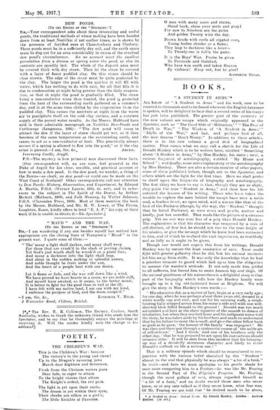DEW PONDS.
[To THE EDITOR OP THE " SPECTATOR:]
Sits—Your correspondent asks about these interesting and useful ponds, the traditional methods of whose making have been handed down from at least Neolithic if not earlier times, as is shown by the presence of fortified ones at Chanctonbury and Cissbury. These ponds must be in a sufficiently dry soil, and the earth space must be dug cut for an area considerably in excess of the eventual
dew pond's circumference. On no account must the smallest percolation from a stream or spring enter the pond, or else its contents are speedily lost. The whole of the dug-out area must be covered thick with dry straw. Then let the straw be covered with a layer of finest paddled clay. On this stones should be close strewn. The edge of the straw must be quite protected by the clay. The larger the pond is the quicker it will fill with water, which has nothing to do with rain, for all that fills it is due to condensation at night being greater than the daily evapora- tion, so that at night the pond is gradually filled. The straw being a non-conductor when thus treated, the pond is protected from the heat of the surrounding earth gathered on a summer's day, and is at the same time chilled by the evaporation from the paddled clay. This causes the moisture at night from the warm air to precipitate itself on the cold clay surface, and a constant supply of the purest water results. As the Messrs. Hubbard have said in their admirable monograph on Neolithic Dew-Ponds and Cattleways (Longmans, 1905) : "The dew pond will cease to attract the dew if the layer ef straw should get wet, as it then becomes of the same temperature as the surrounding earth, and ceases to act as a non-conductor of heat. This practically always occurs if a spring is allowed fa flow into the pond," or if the clay P.8.—The mystery is how primeval man discovered these facts. [Our correspcndent will, we are sure, feel grateful to the Duke of Argyll for his clear, sensible, and practical account of how to make a dew pond. Is the dew pond, we wonder, a thing of the Downs—no chalk, no dew pond—or could one be made on the West Coast of Scotland? Other correspondents call our attention to Dew Ponds: History, Observation, and Experiment, by Edward A. Martin, F.G.S. (Werner Laurie, 1915, Gs. net), and to refer- ences to the subject in The Spirit of the Downs, by Arthur Beckett (Methuen, 1909), and Folk Memory, by Walter Johnson, F.G.S. (Clarendon Press, 1908). Most of them mention the book by the Messrs. Hubbard, and Mr. H. W. Lewer, of The Priors, Loughton, Essex, kindly offers to lend "E. A. P." his copy of their work if he is unable to obtain it.—ED. Spectator.]


























 Previous page
Previous page